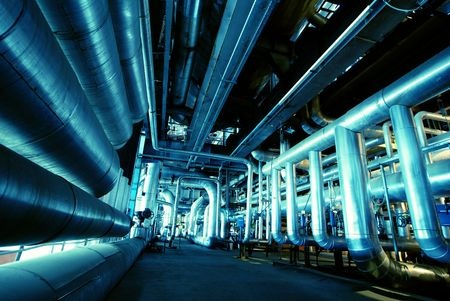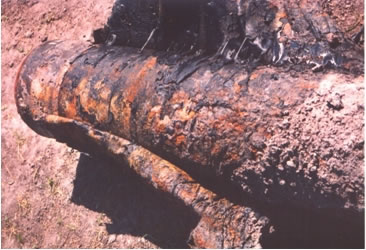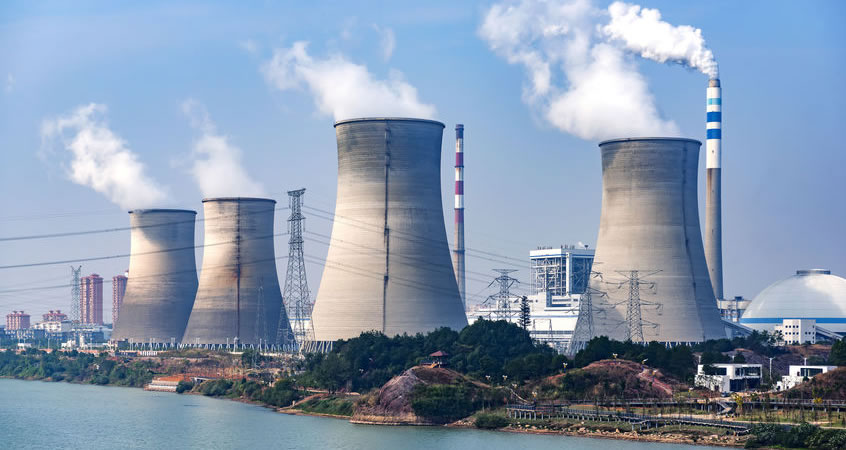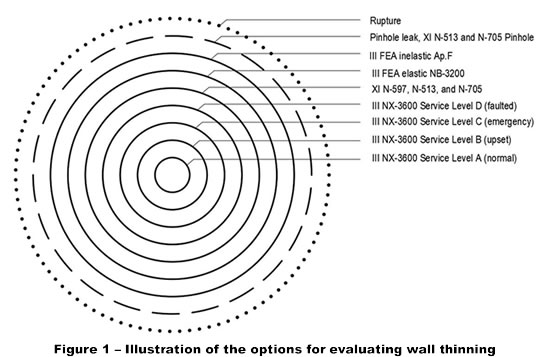The Meaning of the Class 1 Nuclear Piping Equations in NB-3650

Below we review the meaning of the six Class 1 piping stress equations in ASME III NB-3650, Class 1. The nomenclature is found in NB-3650.
Two things must be kept in mind when applying these Class 1 piping equations:
- All the stresses are elastically calculated, i.e. the calculation model considers the material to be such that s = E e, even when the stress exceeds yield.
- All the stress terms are stress intensities, i.e. twice the maximum shear stress. Using the Tresca criterion for elastic behavior, the stress intensities can be compared directly to yield.
EQUATION (9)
B1 (P Do)/(2 t) + B2 Do/(2 I) Mi ≤ k Sm Eq.(9)
Equation (9) is a primary stress intensity amplitude equation. It is meant to prevent failure by structural instability of the joint or fitting (elbow, tee, reducer, etc.). For example, for an elbow with in-plane bending, Eq.(9) will prevent the elbow from buckling in the opening or closing position. The stress indices B are based on limit load concepts. Note that pressure, and the B1 index, tends to re-round the cylindrical shape and therefore tends to counter the buckling failure. Sometimes Eq.(9) is referred to as prevention of collapse.
For the Design and Service Level A (normal) conditions, which consist of sustained loads (pressure, weight) k = 1.5, so that 1.5Sm » Sy and structural instability is prevented. For Service Level B conditions (upset, typically including OBE) k = 1.8 but not greater than 1.5Sy, to prevent any permanent deformation. For Service Level C conditions (emergency, typically fewer than 25 cycles of stress above a certain limit) some local permanent deformation is permitted and k = 2.25 but not greater than 1.8Sy. For Service Level D (faulted, typically including SSE and pipe break) so-called gross permanent deformation is permitted and k = 3 but not to exceed 2Sy. After the publication of these equations in 1969 B31.7, and their linkage to “local” and “gross” permanent deformation, work by D. Terao and E. Rodabaugh (NUREG-1367, 1992) indicated that the Service Level D stress limits (faulted), under most conditions, the deformations were not so “gross” as to affect the flow capability of the pipe cross-section.
EQUATION (10)
Sn=C1 (Po Do)/(2 t) + C2 Do/(2 I) Mi + C3 Eab |αa Ta – αb Tb | ≤3 Sm Eq.(10)
Equation (10) is a primary plus secondary stress intensity range equation. It is the equivalent of NB-3200 PL + Pb + Pe + Q. It is meant to assure that as the pipe is subjected to cyclic loads of pressure, moment, and axial temperature gradients, the pipe material will shakedown to elastic action (s = E e) after a few cycles, or another way to say it is that the material will not plastically ratchet, i.e. will not accumulate plastic strains at each load cycle. Meeting Equation (10) would permit us to directly use the (S,N) fatigue curves in ASME III Appendix I, without having to apply a Ke plasticity correction factor in Equation (14). Mi is the range of resultant moment loading that cycle (thermal expansion, anchor movement, seismic, etc.) but not weight moments since they do not produce a cyclic stress range.
EQUATION (11)
Sp= K1 C1 (Po Do)/(2 t) + K2 C2 Do/(2 I) Mi + K3 C3 Eab |αa Ta – αb Tb | + K3 (E α |∆T1 |) / (2(1- ν))+(E α |∆T2 |)/(1- ν) Eq.(11)
Equation (11) is a peak stress intensity range equation. It is used if Equation (10) is met (i.e. shakedown has been established). Eq.(11) calculates the total peak stress intensity range in the pipe fitting or component due to the cyclic pressure, moments, and axial (Ta Tb) and through-wall (DT1 and DT2) temperature gradients. Note that the calculation of Ta, Tb, DT1 and DT2 requires a heat transfer analysis, which in turn requires a complete characterization of the fluid transient: flow rate vs. time, temperature vs. time and pressure vs. time. These transients, sometimes dozens of them for a given location, are provided in the ASME III Class 1 Design Specification for the system. Eq.(11) is the equivalent of NB-3200 PL + Pb + Pe + Q + F. As in vessel design (NB-3200 and NB-3300), there is no limit on the peak stress intensity range, its importance is its potential to initiate and propagate a fatigue crack. This will be controlled by the fatigue check in Eq.(14).
EQUATION (12)
Se = C2 Do/(2 I) Mi* ≤ 3 Sm Eq.(12)
If shakedown cannot be established by meeting Eq.(10), then NB-3650 provides a shakedown alternative: To meet separately Eq.(12) and Eq.(13). The intent of Eq.(12) is to prevent plastic hinges to form under thermal expansion and contraction moments Mi*.
EQUATION (13)
Sn=C1 (Po Do)/(2 t)+C2 Do/(2 I) Mi + C3‘ Eab |αa Ta – αb Tb | ≤ 3 Sm Eq.(13)
Eq.(13) goes hand-in-hand with Eq.(12) as the shakedown alternative to Eq.(10). The intent of Eq.(13) is similar to NB-3228.4(b) which limits the accumulated plastic strains, a condition necessary to justify the applicability of Ke in Eq.(14).
EQUATION (14)
Salt = Ke Sp/2 Eq.(14)
Eq.(14) is the alternating stress intensity that is entered in the (S,N) fatigue curve to obtain the code-permitted number of cycles given Salt. The division by 2 is simply a convention since the vertical axis of the ASME III Appendix I fatigue curve is plotted as stress amplitudes, i.e. half the stress intensity range Sp. The plasticity correction factor Ke is 1.0 if Eq.(10) is met (i.e. shakedown with practically no plastic ratcheting), and larger than 1.0 if Eq.(10) is not met by Eq.(12) and (13) are met. If neither Eq.(10) nor Eq.(12) and (13) are not met, then the fatigue analysis cannot proceed. Ke is a conservative correction to predict the actual plastic strain, having performed all the analyses using an elastic model.
Have a question or would like more information? You may post to this blog or click the link below for more help.






